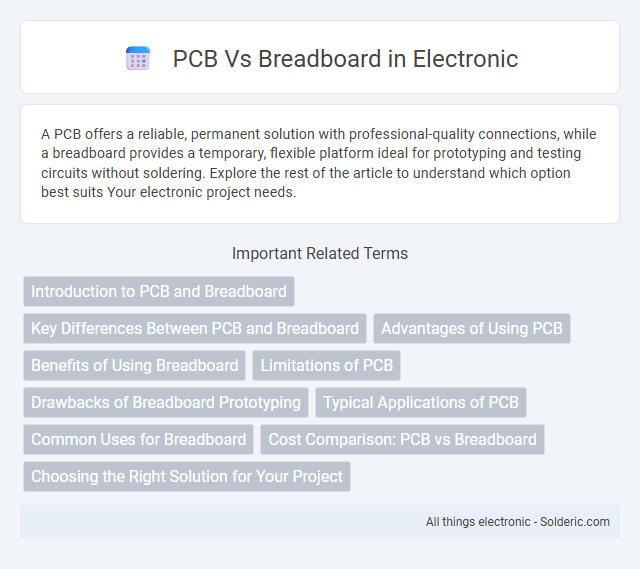A PCB offers a reliable, permanent solution with professional-quality connections, while a breadboard provides a temporary, flexible platform ideal for prototyping and testing circuits without soldering. Explore the rest of the article to understand which option best suits Your electronic project needs.
Comparison Table
| Feature | PCB (Printed Circuit Board) | Breadboard |
|---|---|---|
| Purpose | Permanent circuit assembly | Temporary prototyping and testing |
| Durability | High; stable and reliable | Low; connections can loosen |
| Assembly | Soldered components | Plug-and-play, no soldering |
| Complexity Support | Supports complex, multi-layer designs | Limited to simple circuits |
| Cost | Higher initial cost but cost-effective for mass production | Low cost, reusable |
| Time | Longer design and manufacturing time | Instant setup and modifications |
| Signal Integrity | Excellent due to controlled layout | Prone to noise and signal issues |
| Size and Form Factor | Customizable, compact designs | Bulky, fixed form factor |
Introduction to PCB and Breadboard
A Printed Circuit Board (PCB) provides a permanent, compact platform for electronic components by mechanically supporting and electrically connecting them through etched copper tracks. Breadboards enable rapid prototyping and testing by allowing temporary, solderless connections on a grid of spring-loaded contacts. Both tools are essential in electronics development, with PCBs suited for final product assembly and breadboards ideal for experimentation and circuit design validation.
Key Differences Between PCB and Breadboard
Printed Circuit Boards (PCBs) offer permanent, reliable electrical connections through etched copper pathways, while breadboards provide temporary, reusable platforms for prototyping without soldering. PCBs are designed for mass production with compact, customizable layouts that support complex circuits, whereas breadboards are suitable for simple, experimental setups due to their limited current capacity and potential connection instability. The structural rigidity and durability of PCBs contrast with the flexibility and ease of modification inherent in breadboards, influencing their respective uses in final products versus initial design testing.
Advantages of Using PCB
Printed Circuit Boards (PCBs) offer superior durability and reliability compared to breadboards, ensuring stable electrical connections and reducing the risk of short circuits. PCBs enable compact and organized layouts, making them ideal for mass production and professional-grade electronic assemblies. Your projects benefit from easier troubleshooting and enhanced performance due to precise component placement and soldered joints on a PCB.
Benefits of Using Breadboard
Breadboards offer rapid prototyping and easy circuit modifications without soldering, making them ideal for testing and debugging electronic designs. Their reusable nature reduces costs and saves time during the development phase. Breadboards support a wide range of components and provide clear visual layout, enhancing learning and experimentation for beginners and professionals alike.
Limitations of PCB
Printed Circuit Boards (PCBs) have limitations including high initial design and manufacturing costs, making them less ideal for rapid prototyping or small-scale projects compared to breadboards. Once fabricated, PCBs lack flexibility for quick modifications or troubleshooting, as changes require redesign and remanufacturing. Complex or multi-layer PCB designs also demand advanced knowledge and tools, which can increase development time and expenses.
Drawbacks of Breadboard Prototyping
Breadboard prototyping often suffers from unreliable electrical connections due to loose contacts and intermittent connections, which can lead to debugging challenges and inconsistent circuit performance. The high parasitic capacitance and inductance introduced by breadboard jumper wires negatively affect high-frequency signal integrity and overall circuit accuracy. Additionally, breadboards are not suitable for permanent designs as their mechanical fragility and lack of durability result in frequent component displacement and signal degradation.
Typical Applications of PCB
Printed circuit boards (PCBs) are commonly used in commercial electronics, automotive systems, and medical devices due to their reliability and ability to support complex circuitry. Unlike breadboards, PCBs provide durable, permanent connections essential for mass production and high-frequency applications. Your projects benefit from PCBs when requiring consistent performance and compact design integration.
Common Uses for Breadboard
Breadboards are primarily used for prototyping and testing electronic circuits due to their reusable, solderless design that allows easy component insertion and removal. They enable rapid experimentation and modification, making them ideal for beginners, educators, and engineers developing circuit designs before committing to a printed circuit board (PCB). Your ability to quickly troubleshoot and adjust connections on a breadboard accelerates innovation and learning in electronic projects.
Cost Comparison: PCB vs Breadboard
Printed Circuit Boards (PCBs) typically have a higher initial cost due to design and manufacturing processes but offer long-term savings through durability and reduced assembly time. Breadboards are cost-effective for prototyping and small projects as they require no manufacturing fees and allow quick modifications. Your choice depends on project scale and budget, with breadboards favoring short-term flexibility and PCBs supporting mass production and reliability.
Choosing the Right Solution for Your Project
When deciding between a PCB and a breadboard for your project, consider the complexity, durability, and production volume requirements. PCBs offer reliable, compact, and repeatable solutions ideal for final products or mass production, while breadboards provide a flexible, reusable platform perfect for prototyping and testing circuits quickly. Evaluating the trade-offs in cost, assembly time, and performance will help you choose the optimal solution for your design objectives.
PCB vs breadboard Infographic

 solderic.com
solderic.com